Roles of raindrop impact in detachment and transport processes of interrill soil erosion
Xunchang John Zhang
USDA-ARS Grazinglands Research Lab., El Reno, OK, 73036, USA
Keywords:Interrill erosion process Raindrop detachment Raindrop entrainment Raindrop-driven transport Flow-driven transport Raindrop-flow interaction
A B S T R A C T To date the roles of raindrop impact in sediment entrainment and transport processes of interrill soil erosion are not yet fully quantified.The objectives are to 1) evaluate the effects of raindrop impact on sediment entrainment, 2) systematically quantify the relative importance of raindrop-driven and flowdriven transport, and 3) characterize sediment size distributions in different sediment transport regimes.A loam soil with 48.4%sand and 23%clay was packed into flumes(L×W×H:1.8×0.5×0.1 m)and subjected to intensities of 60,90,120 mm h-1 at gradients of 5,10,and 16°.Air filter and tarp covers were used to vary impact energy and flow length.Results show that sediment is largely entrained by raindrop impact and transported by raindrop-impacted flow.Interrill erosion consists of two composite processes: raindrop-induced detachment/entrainment and raindrop-impacted flow transport.The former includes direct detachment by raindrop impact and ‘flow detachment’.The latter includes raindrop-driven and flow-driven transports.The proportions between the two transports vary with slope steepness, slope length, flow depth (or flow discharge), rainfall intensity, and sediment characteristics.Raindrop-driven transport is competent but inefficient, while the opposite is true for flow-driven transport.Because raindrop impact plays dual roles in detaching soil (and/or entraining sediment) and enhancing sediment transport, a drop energy factor must be included in interrill erosion models to adequately simulate the dual roles.More studies are required to derive a drop energy function that takes into consideration the rainfall energy dissipation by canopies of various plants under natural conditions.
1.Introduction
Ellison (1945, 1947) described overland soil erosion during rainfall as two key processes: soil detachment and sediment transport.Soil detachment was mainly caused by raindrop impact and surface flow shear, and sediment transport by raindrop splash and surface flow.Meyer et al.(1975) further divided overland soil erosion into rill and interrill erosion.Rill erosion is the translocation of soil by concentrated overland flow along small channels that can be obliterated by tillage operations.Concentrated flow power is responsible for both detaching and transporting sediment in rills.Interrill erosion is the translocation of soil mainly caused by raindrop-impacted sheet flow between rills.In interrill erosion, soil detachment is primarily caused by raindrop impact and sediment transport by raindropimpacted sheet flow (Guy et al.,1987; Meyer et al.,1975; Young and Wiersma, 1973), while direct detachment and transport by sheet flow alone without raindrop impact are negligible(Lattanzi et al., 1974; Meyer et al., 1975).Raindrop impact, which plays dual roles in interrill erosion, not only detaches soil but also enhances sediment transport capacity of sheet flow (Guy et al.,1987; Singer and Walker 1983; Zhang, 2019).Furthermore,Zhang et al.(2020) reported that positive interaction between raindrop impact and sheet flow could also enhance soil detachment, and such enhancement was referred to as ‘flow detachment’ to distinguish it from the conventional raindrop detachment.
Although raindrop or soil splash rates may not be the same as the actual soil detachment rates by raindrop impact, soil splash has been viewed as a surrogate for total raindrop detachment(Nearing and Bradford, 1985; Parsons et al., 1994).It has been reported that soil splash rates declined exponentially with water depth due to the protection of a water layer (Gilley et al., 1985;Morgan et al., 1998; Moss and Green, 1983; Torri et al., 1987).However, Moore and Singer (1990) and Young and Wiersma(1973) reported that soil splash increased with flow depth of<1 mm within a rainfall event.Zhang et al.(2020) also showed that splash rates measured in a slot generally increased with mean flow depths of<1 mm.The increase in splash rates in the presence of an ultrathin water depth may be attributed to the positive interaction between raindrop impact and flow depth(Zhang et al.,2021).Nouhou Bako et al.(2019) simulated individual raindrop impacts on various water depths using computational fluid and reported that soil detachment peaked at a particular depth(ca.< 4 mm) as an integrated result of the balance between the shear stress development and the protective effect of a water layer.The shock wave created by the impact of a raindrop on a thin water layer could cause more soil detachment than the raindrop impact alone without a thin water layer.The enhanced detachment was caused by the creation of shear stresses that propagate radially far beyond the impact area and last longer than the direct impact of a raindrop including crater opening and closing.It is likely that as flow depth increases, direct raindrop detachment could decrease while flow detachment could increase due to increased extent and duration of shear stress development created by raindrop impacts.However, more experiments are needed to characterize the flow detachment caused by shock waves created by raindrops impacting an ultrathin water layer.
On interrill erosion areas, different sediment transport modes were summarized by Kinnell(2005,2009),which include raindrop splash, raindrop-induced rolling and saltation, flow-driven rolling and saltation, and suspension transport.Zhang et al.(2020, 2021)suggested that the saltation mode on interrill erosion areas was trivial due to the ultrathin flow depth while bed load sliding or rolling driven by raindrop impact or sheet flow prevails.Although these transport modes can occur simultaneously on the same area,the dominant modes depend on rainfall intensity,flow depth,slope gradient,and slope length(Kinnell,2005,2009;Zhang et al.,2020;Zhang and Wang, 2017).Except suspension transport, dominant transport modes vary with slope length downslope for a given rainfall intensity and a slope gradient.For a very short slope length,raindrop splash transport dominates due to little surface runoff.As slope length increases downslope, raindrop-driven transport intensifies as runoff accumulates.When the power of flow is large enough to transport particles that are set in motion or entrained by raindrop impact, flow-driven transport becomes dominant.When the accumulated flow is able to detach soil particles without raindrop impact stimulation,rill erosion may commence.Generally,the relative importance of raindrop-driven transport tends to decrease downslope while that of flow-driven transport increases (Kinnell,2005, 2009; Zhang and Wang, 2017).The dominant transport modes are also affected by rainfall intensity and slope steepness.As rainfall intensity and/or slope steepness increases, the spatial patterns of the dominant transport modes shift upslope.Zhang et al.(2020) for the first time estimated the relative contributions of flow-driven transport vs.raindrop-driven transport using a window screen cover at one slope length and reported that raindropdriven transport increased with rainfall intensity and slope steepness.
To date,the effects of flow length on interrill sediment transport processes, as affected by rainfall impact energies and slope gradients,are not yet fully quantified.The objectives of this study are to systematically quantify the relative importance of raindrop-driven and flow-driven transport on interrill erosion areas as affected by flow lengths, rainfall intensity, and slope gradient, and to further characterize sediment size distributions in different sediment transport regimes.
2.Materials and methods
2.1.Soil particle distribution and aggregate fraction
Soil sample was collected from the tillage layer of a loam soil(fine-silty, mixed, superactive, thermic, Pachic Haplustolls) at the Agronomy Farm of the ARS Grazinglands Research Laboratory, El Reno, OK, U.S.A.The soil sample was sieved through a 12-mm screen to remove plant materials before being packed into experimental flumes.
For analyzing the primary particle size distribution,the original soil was air dried and sieved through a 2-mm sieve.An approximately 100-g sample was transferred to a 250-mL plastic bottle.150 mL of 5% dispersing solution (sodium hexametaphosphate)was added.The sample was shaken with a horizontally oscillating shaker for 24 h.The sample was sieved sequentially through the four sieves of 1,0.5,0.1,and 0.063 mm.The sediment caught in each sieve was transferred to an aluminum pan with a wash bottle.For the clay fraction(<0.002 mm),a 10 mL aliquot was withdrawn from the 2.5 cm depth after 2-h sedimentation(Miller and Miller,1987).For the <0.063 mm fraction (silt and clay), the entire sieved suspension was then oven dried.Five replicates were made.
To measure aggregate fractions,around 100-g air-dried soil sample was slowly wetted with a spray bottle to near field capacity before being transferred to a 250-mL bottle.150 mL of de-ionized water was added to the bottle,and the sample was shaken for 20 min.Next,the sample was sieved with the four sieves,and the sediment caught on each sieve was oven dried.After weighing the oven-dried sediment samples,each sieved sediment sample was transferred to a 100-mL beaker with 75 mL of de-ionized water added, and then physically dispersed with a Sonicator(W-385)for 1 min.The sonicated sample was sieved again with the same sieve to measure primary particles retained on the screen.The percent aggregate for each size fraction was calculated as the weight difference between before and after sonication divided by the weight before sonication.
2.2.Rainfall simulator
The rainfall simulator has four downward-spray oscillating nozzles (80150), which are spaced 0.9 m apart and aligned perpendicular to the oscillation direction (Meyer and Harmon,1979).The nozzles were placed 3 m above the test beds.The nozzle pressure was set to 41 N m-2(6 psi),which generates an exit velocity of 8.8 m s-1.The drop sizes range from 0 to 6 mm with a median of about 2.5 mm.The nozzles deliver an energy of 275 kJ ha-1mm-1, which does not vary with rainfall intensity because the intensity is controlled by the frequency of nozzle sweeps.The three intensities of 60,90,and 120 mmh-1were used.The relative rainfall uniformity in the test area was greater than 86%.De-ionized water was used in the rainfall simulation.
2.3.Flume setup
Two replicate plots were placed side by side with a 2.5-cm gap in between for collecting soil splash.Each plot was 1.8 m long,0.5 m wide, and 0.1 m deep with a perforated bottom for drainage.The plots were visually divided into 4 sections of 45 cm each for controlling slope length with a tarp cover (Fig.1A, C).The tarp cover was to intercept rainfall and divert collected rainwater out of the plot.Before the soil was packed into runoff plots,the soil was sieved through a 12-mm sieve at about 10% soil moisture by weight.A 3-cm sand layer was added to the bottom,and a 7-cm soil layer was packed over the sand layer with a nylon screen in between.The soil was loosely packed to a target bulk density of 1.2 g cm-3for simulating the freshly tilled soil.
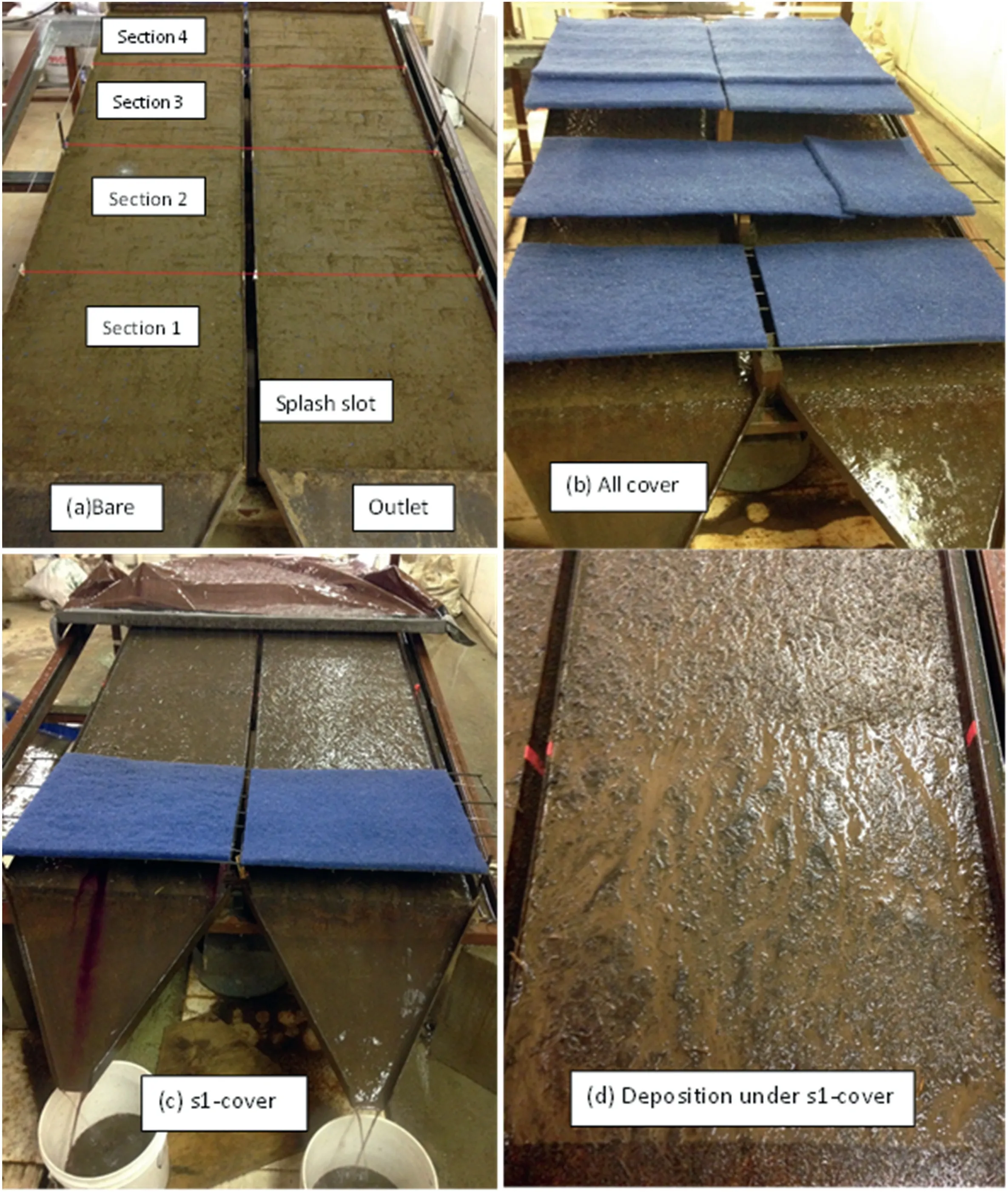
Fig.1.(A)Newly packed flume surfaces, division of 4 sections,and splash slot between the flumes; (B)all or full cover with air filter;(C)tarp cover in section 4 and filter cover in section 1; and (D) fine and medium sand deposition in section 1 under filter cover.
2.4.Treatment and experiment procedure
The rainfall simulation experiments were conducted at three rainfall intensities (60, 90, and 120 mm h-1) at three slope gradients of 5,10,and 16°(9,18,and 29%).A total of nine rainfall events were carried out,and each lasted about 1 h.Two side-by-side plots were used as replicates (Fig.1A).The plots were packed anew for each rainfall event.The entire plots were also covered with air filters and prewetted at 30 mm h-1until the start of runoff(Fig.1B).Sampling procedure, flow length control, and air filter and tarp cover treatments for each rainfall event at each slope gradient and rainfall intensity are shown in Table 1.Each runoff sample was collected at an interval of 7 min.To vary the flow length,a tarp was used to cover section 2 (s2) to s4 for samples 1 and 2, s3 to s4 for samples 3 and 4,and s4 for samples 5 and 6(Fig.1C).There was no tarp cover for samples 7 and 8.For each flow length (or tarp treatment),s1 was first bare soil and then covered with an air filter to collect two contrasting samples.The contrasting pair for each flow length were used to assess the effects of raindrop impacts on sediment transport at different flow lengths or rates.Additionally,sample 9 was collected at the 10°and 16°slopes when the entire plots were covered with air filters (Fig.1B).
2.5.Sample collection and processing
Each runoff suspension sample was collected from the flume with a 7.5-L plastic bucket every 7 min.Soil splash was collected from a 2.5-cm wide slot in section 1 with a plastic tub (33 cm long and 25 cm wide) that was centered underneath the slot when s1 was bare (i.e., simultaneously when samples 1, 3, 5, 7 were collected).Sheet flow velocity was measured over the 45 cm length in s1(lowest section)with a dye method using a stopwatch and a KMnO4solution.Five velocity measurements were taken during each 7 min interval.Immediately following the rainfall event, all runoff suspension samples were weighed and sequentially sieved through a set of screens with openings of 1,0.5,0.1,and 0.063 mm.The sediment caught on each screen was transferred to a beaker with a wash bottle.For the <0.063 mm fraction (silt and clay), immediately after the sieved runoff suspension was vigorously mixed, a volume of 5 mL was taken using a pipette and transferred to an aluminum pan.After 2 h settling, another 5 mL was taken at the 2.5 cm depth for measuring clay fraction of <0.002 mm.All sediment samples were oven dried for 24 h at 105°C before weighing.
2.6.Data analysis
The soil splash measured in the slot was upscaled to the entire s1 by an area ratio of 27.3(i.e.,s1 area over slot area)to obtain the total soil splash in s1 during the 7-min collection, assuming a uniform and balanced splash rate in s1.Mean Weight Diameter(MWD)was calculated by weighting the mid-diameters of each size group (i.e., 1.5, 0.75, 0.3, 0.082, 0.033, and 0.001 mm) by their corresponding weight fractions.The proportional sediment transport driven by raindrop impact was estimated by comparing sediment deliveries between the s1-bare and s1-cover treatments for each flow length.That is, the percent raindrop-driven transport was estimated as the difference in sediment deliveries between the bare and cover treatments divided by the delivery in the bare treatment.The average flow depth near the flume outlet was calculated as:
where h is the average flow depth in cm,Q is the water discharge in mL s-1,w is the plot width in cm,and V is the mean flow velocity in cm s-1.The flow stream power(ω) was computed as:
where γ is water density (kg m-3), g is gravitational acceleration constant(m s-2),S is the sine of the slope angle,and q is unit water discharge (m2s-1).
2.7.Statistical analysis
A Pearson correlation analysis was conducted between sediment concentration, soil splash, flow velocity, and depth.MWDs were contrasted using a paired two-tail t-test between the s1-bare and s1-cover treatments.Three-way factorial analysis of variance(ANOVA) was carried out to test the effects of rainfall intensity,slope steepness, slope length (or flow discharge), and their interactions on soil splash, raindrop-driven sediment transport in section 1, and MWD of sediment when s1 was either bare or covered(SAS Institute,1990).
3.Results
3.1.Soil particle size distribution
Primary particle size distribution and aggregate fractions in each size group are shown in Table 2.The soil consists of 48.4%sand, 28.6% silt, and 23.0% clay.Soil aggregates account for about 96%for very coarse and coarse sand size fractions,50%for fine and medium sand, and 32% for very fine sand, showing that coarser fractions contain more aggregates.
3.2.Soil splash
Splashed sediment measured in the splash slot generally increased with slope gradients,rainfall intensities,and slope lengths or flow rates (Fig.2).A three-way analysis of variance showed that the main effects of slope gradient,rainfall intensity,and slope length on soil splash were all positive and significant at P <0.0001.The positive interaction between slope gradient and length was significant at P = 0.004, and the interaction between intensity and slope length was significant at P = 0.05.But the interaction between intensity and slope gradient was not significant at P= 0.1.
3.3.Raindrop-driven and flow-driven sediment transport
Unit sediment discharge as affected by slope gradient, rainfall intensity, and slope length are shown in Fig.3 for the contrasting cases of bare vs.s1-cover.In general, unit sediment discharge in runoff increased with slope gradient, rainfall intensity, and slope length.The difference in unit sediment discharges between the bare and s1-cover treatments at a given slope length might be characterized as the contribution from raindrop-driven sediment transport.This contribution included the effects of direct raindrop impacts as well as the positive raindrop-flow interaction.The remaining contribution would be from flow-driven transport if only two transport modes of flow-driven and raindrop-driven transport can be assumed in interrill sediment delivery.Based on this assumption, the percent proportions of raindrop-driven transport were calculated and presented in Fig.4 as positive numbers.To better reflect the trends,data in Fig.4 were regrouped and averaged by slope, intensity, and flow lengths (Table 3).Generally, the relative contributions of raindrop-driven transport were greater when flow discharges were smaller (or flow lengths were shorter) for each rainfall intensity.In other words, the relative contributions from flow-driven transport increased as flow discharge increased.The relative contribution of the raindrop-driven transport tended to decrease as slope steepness increased for a majority of cases but increased as rainfall intensity increased.A three-way analysis of variance showed that the three main effects of intensity, slope gradient, and slope length on raindrop-driven transport were significant at P <0.0001.All the two-way interactions as well as the three-way interaction were significant at P = 0.05.
3.4.Particle size distributions of raindrop-driven and flow-driven sediment
Percent proportions of wet-sieved sediments including soil aggregates for four slope lengths and three intensities at the 5°and 16°slopes are shown in Fig.5 as a demonstration.A paired t-test between bare and s1-cover(n=72)showed that MWD in the bare treatment was much coarser than that in the s1-cover treatment(P<0.0001).The former was 0.153 mm while the latter was 0.137 mm.There was a clear trend that the particle size composition became finer when s1 was covered as opposed to being bare.Specifically,silt and clay fractions(<0.06 mm)would increase while the coarser fractions of>0.06 mm,especially very fine sand size(0.06-0.1 mm)and fine and medium sand sizes(0.1-0.5 mm),would decrease for most slope lengths, intensities, and slope gradients.However, the shifts to finer composition tended to become less obvious at longer slope lengths, higher intensities, and steeper gradients due to increased stream power.The sediment composition was coarser at steeper slopes, but the coarsening was lessened at higher rainfall intensities.The coarsening could also be seen when rainfallintensity increased at a given slope gradient.The percent fractions of coarse sand size(0.5-1 mm)and very coarse sand size(>1 mm)were greater at shorter slope lengths where raindrop-driven transport predominated.A three-way ANOVA showed that MWD in the s1-cover treatment (or in the flow-driven transport) was significantly impacted by intensity (I), slope gradient (S), slope length (L), and the interactions of I*L and S*L at P < 0.05, while MWD in the bare treatment was influenced by I, S, I*S, and S*L.Additionally, sediment composition was much finer when the entire plot was covered with an air filter than when only s1 was covered(Fig.5d,e,f).The sediment composition became even finer when only inflow was introduced (Fig.5f).

Table 2 Primary particle size distribution and percent soil aggregate in each size class.
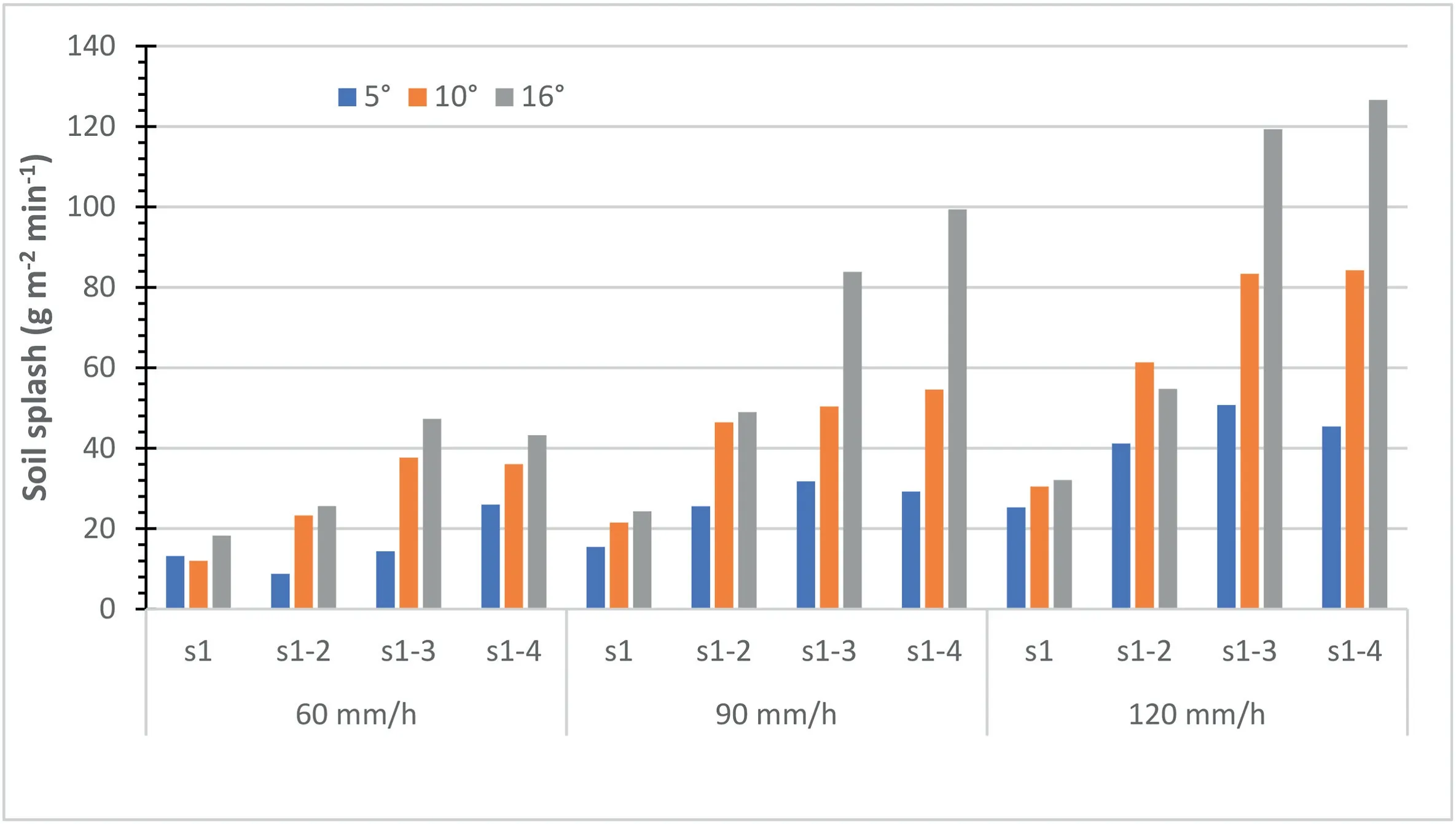
Fig.2.Slot soil splash in section 1 as affected by slope gradient, slope length (or flow discharge), and rainfall intensity.
3.5.Partitioning sediment transport processes
Unit sediment discharges at the full flow length of 1.8 m and two slope gradients of 10 and 16°are shown in Fig.6 for three contrasting cover treatments (i.e., bare, s1-cover, and full cover).In addition,an inflow-only treatment was introduced at the top end of the 16°slope immediately following the 120-mm h-1rainfall event.The unit water discharge rates at the outlet were 2.38, 2.60, 2.98,and 2.83 L min-1m-1for the bare,s1-cover,full cover,and inflowonly treatments,respectively.Overall,the unit sediment discharges decreased from full bare to s1 cover to full cover for all rainfall intensities and slope gradients.The unit sediment discharge of the inflow-only treatment was much smaller than that of the full cover treatment at a similar water discharge rate.Since there were loose materials on the soil surface following rainfall simulation, the inflow-only treatment was supposed to represent 100% of ‘flowdriven sediment transport’, which was defined as the removal of loose particles by flow without raindrop stimulation by Kinnell(2009).The sediment discharge under rainfall in the full cover was largely caused by flow-driven transport with minor stimulation by drops newly formed in the air filter.The sediment discharge in the s1 cover treatment reflected the ability of the flow to transport sediment after entrainment upslope by raindrop impact.Suspension transport and flow-driven rolling and sliding were the main transport modes in the full and s1 cover treatments.In the full bare treatment, both raindrop-driven and flow-driven transport were on full display, in which the raindrop-driven rolling and sliding augmented the flow-driven transport.
3.6.Modeling interrill sediment delivery
Unit sediment delivery rates were plotted with stream power for the bare and s1-cover treatments(Fig.7).Numbers of segments(or slope length)are shown in the data label,and the three identical numbers represented three intensities.Linear relationships could be found for each treatment and slope gradient, indicating that stream power could be a good predictor for interrill sediment delivery for either cases of with or without raindrop impact in s1.However, stream power could not explicitly simulate the enhancement of sediment transport by raindrop impact or the contribution of raindrop-driven transport because raindrop impact does not alter stream power.
4.Discussion
4.1.Soil splash and raindrop-induced detachment
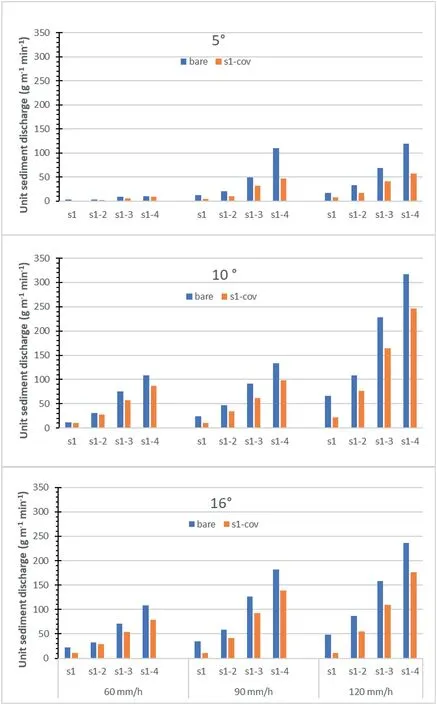
Fig.3.Unit sediment discharge rates for three slope gradients, three rainfall intensities, four slope lengths under the two contrasting treatments of full bare and s1-cover.
In interrill erosion, raindrop impact is the primary force detaching soil,and raindrop-impacted sheet flow is the main agent transporting sediment (Meyer et al., 1975; Young and Wiersma,1973).It has been speculated that soil splash may not be an exact measure of total soil detachment by raindrop impact, simply because not all detached materials can become air-born (Kinnell,2022; Zhang, 2019).Since there is no method available for directly measuring total raindrop detachment, it is a common practice to use soil splash as a surrogate for total raindrop detachment(Nearing and Bradford,1985;Parsons et al.,1994).Soil splash is measured with either a splash cup or splash slot.As an infinitesimal source, a splash cup may approximate raindrop detachment;while a splash slot,as an infinitesimal sink,measures total detached and re-detached loose materials on the soil surface(Zhang, 2019).Soil splash measured by slot was greater than that measured by cup due to splash of pre-detached materials.
It is generally accepted that raindrop splash rates decline exponentially with water depth due to the protection of a water layer(Morgan et al.,1998;Moss and Green,1983;Torri et al.,1987).However,this study showed that soil splash was positively related to sheet flow velocity (r = 0.743) and flow depth (r = 0.183),corroborating the findings of Moore and Singer (1990) and Young and Wiersma (1973) who reported that soil splash increased with flow depth during a rainfall event.Based on computational fluid simulation of individual raindrop impacts, Nouhou Bako et al.(2019) reported that soil detachment reached its maximum at a certain depth(likely <4 mm), resulting from the tradeoff between the shear stress development and the protective effect of a water layer.Impact of a raindrop on a thin water layer forms shock waves that create peak kinetic energies or shear stresses at the phases of the crater opening and closing (Ferreira and Singer, 1985).The radial flow velocity could be greater than the drop impact velocity on a solid surface(Harlow and Shannon,1967;Huang et al.,1982).The drop impact on a thin water layer could cause more soil detachment than the drop impact or flow alone (Ferreira and Singer, 1985).This enhanced detachment by positive interaction between raindrop impact and water depth due to shock wave formation was termed ‘flow detachment’ by Zhang et al.(2020) to distinguish it from the conventional definition of raindrop detachment.Such flow detachment was also reported by Wu et al.(2018).However, this speculative concept of flow detachment needs to be further studied and verified.
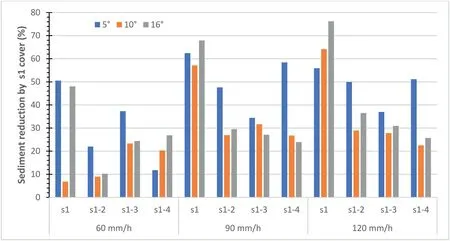
Fig.4.Percent raindrop-driven sediment transport (i.e., sediment reduction by s1-cover) as affected by slope gradient, slope length (or flow discharge), and rainfall intensity.

Table 3 Overall averaged proportions of raindrop-driven sediment transport in percent.
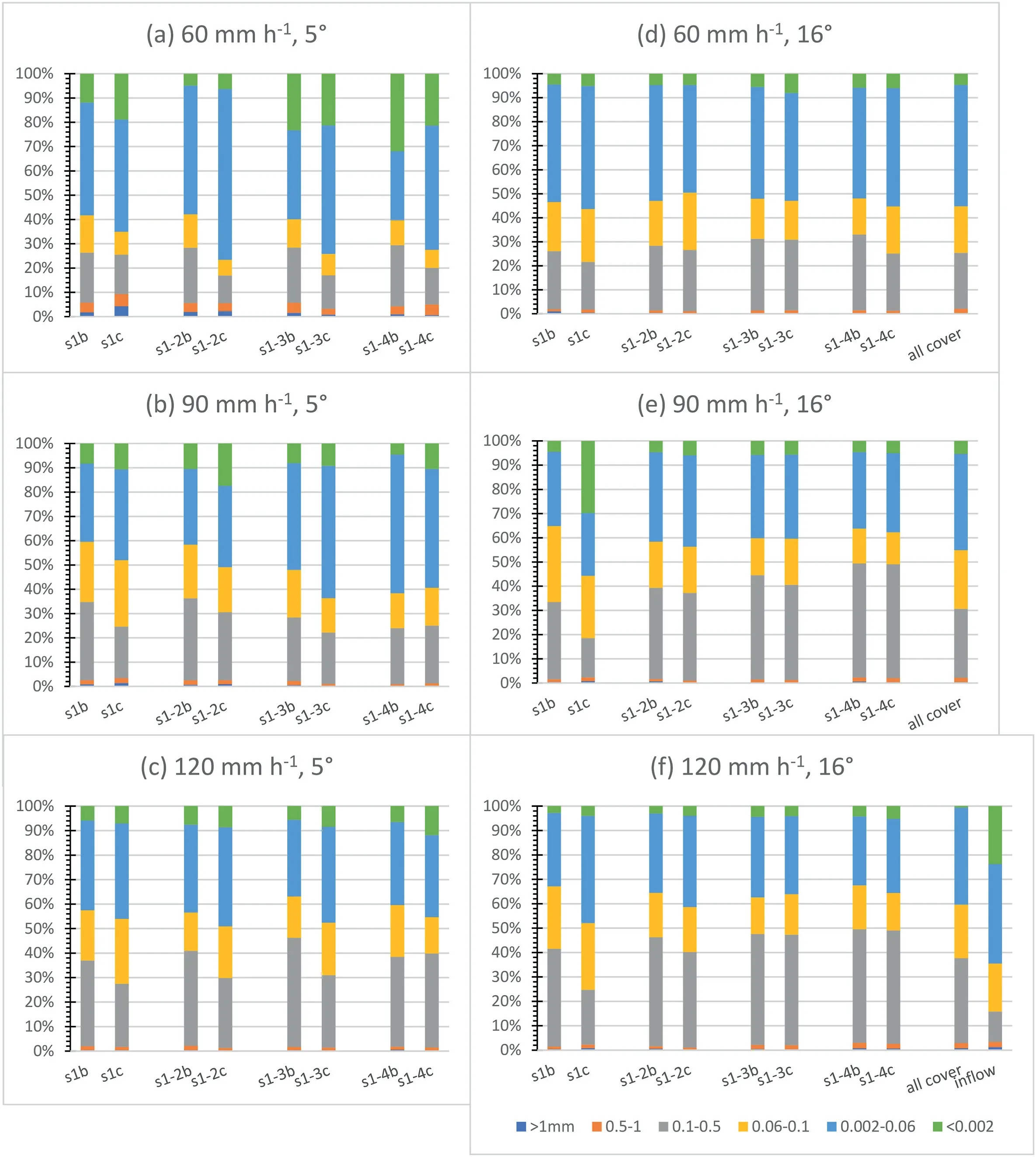
Fig.5.Sediment size distributions at two gradients of 5° and 16°, three rainfall intensities, and four slope lengths in the two contracting full bare and s1-cover treatments.A full filter cover treatment is shown for the 16° gradient and an additional inflow-only treatment at 120 mm h-1.
The positive correlations between soil splash and other factors including rainfall intensity, slope gradient, flow length, flow velocity and depth may be explained as follows.First, there was a strong correlation between soil splash and sediment concentration in runoff (r = 0.686, Table 4 and Fig.2).Because suspended and loose bedload sediment were easily splashed, any factor that increases interrill erosion would increase soil splash.Second, splash angle increases with water depth(Mutchler and Hansen,1970)and high splash angle may increase soil splash efficiency (Al-Durrah and Bradford,1982; Mihara,1952), resulting in more soil splash at a deeper water layer (normally in the range of less than one drop diameter depth).Third, higher flow velocity was more competent to remove detached materials upon the raindrop impact,increasing detachment efficiency of the subsequent raindrop impacts.Since rainfall intensity,slope gradient and length are positively correlated to flow velocity (Table 5), the correlation partially explains their positive relationships with soil splash.Fourth, high intensity rainfall increases the frequency of raindrop impacts and thus soil splash.Fifth, slope gradient directly affects the raindrop impact angle and downslope tangential shear velocity(Ghadiri and Payne,1988) and therefore total soil splash (Brodowski, 2013; Fu et al.,2011).The average flow depths across the end plate were less than 0.5 mm(Table 5),but the maximum depth along the flow lines could reach up to 3-4 mm.Given the tradeoff effects of flow depth on raindrop-induced detachment, direct raindrop detachment would decrease with increasing flow depth due to water protection,but‘flow detachment’as induced by drop impact would increase to a specific flow depth due to increased extent and duration of shear stress created by the shock waves (Zhang et al., 2021).The total detachment from the two processes could be greater than the direct raindrop detachment without a water layer (Ferreira and Singer, 1985).It should be mentioned that the widely accepted knowledge that flow detachment is negligible in the interrill erosion is only correct in the condition when raindrop impact is absent,and the‘flow detachment’ can occur in raindrop-impacted sheet flow when synergistic interaction is strong between flow and drop impact.Thus, the total detachment may be referred to as raindrop-induced detachment for simplicity.For measurement of direct raindrop detachment,a new measurement technique needs to be developed for establishing relationships between the total amounts detached by raindrop and the amounts air splashed (i.e.,for quantifying soil splash efficiency).
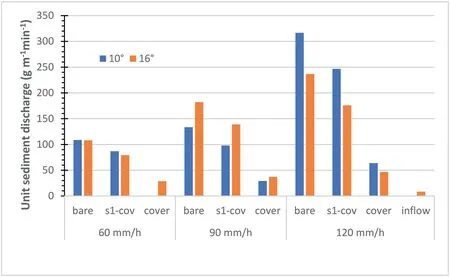
Fig.6.Unit sediment discharge rates for the full flow length of 1.8 m at two slope gradients and three intensities in the full bare,s1-cover, and full cover treatments.An inflow-only treatment is shown for the 16° slope and 120 mm h-1 intensity.
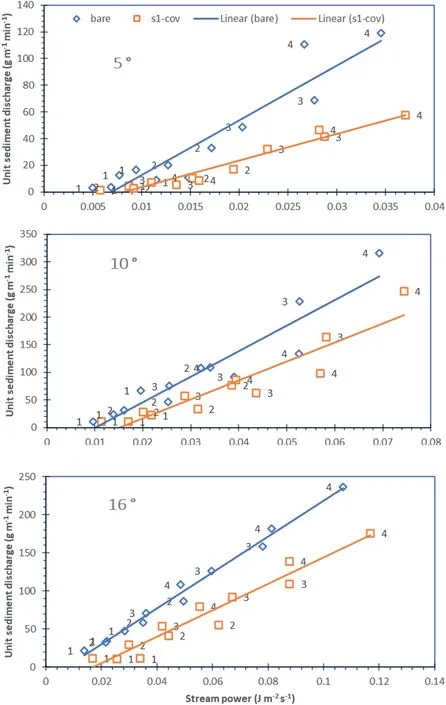
Fig.7.Unit sediment discharge are plotted with stream power for each slope gradient under the contrasting bare and s1-cover treatments.Data labels are section numbers indicating flow lengths and three identical numbers in each plot denote three rainfall intensities.

Table 4 Mean sediment concentration in runoff (g L-1) at the outlet under bare conditions for four flow lengths at three slope gradients and three rainfall intensities,and those under all cover for selected cases.
4.2.Partitioning sediment transport processes
In interrill erosion both soil detachment and sediment transport are influenced by sheet flow hydraulics, rainfall characteristics, soil and sediment properties, and interaction between flow depth and drop size.Modes of sediment transport on the interrill erosion areas include soil splash, suspension, raindrop-driven and flow-driven transport (Asadi et al., 2007; Kinnell, 2005; Zhang et al., 2020).Technically, soil splash falls in raindrop-induced transport and suspension transport in flow-driven transport.In general, the proportions between raindrop-driven and flow-driven transport are a function of slope gradients, slope lengths, rainfall intensities, flow depths, and sediment characteristics.The former predominates at short slope lengths, gentle slope gradients, and high rainfall intensities, where stream power of the sheet flow is low.In contrast,the latter prevails at steep slopes,long slope lengths,and high flow discharges,because flow-driven transport increases with flow power and a proportional increase in flow-driven transport would result in a corresponding decrease in raindrop-driven transport.For example,when averaged over all intensities and slope gradients, raindropdriven transport accounted for approximately 54% of the total transport at a slope length of 45 cm, which declined to only 30% at longer slope lengths (Table 3).When averaged over all slope gradients and lengths, raindrop-driven transport declined from 42% at 120 mm h-1to 24% at 60 mm h-1due to reduced frequency of raindrop impacts.Thus,the relative proportions of the two transport processes depend on erosional conditions.
Little sediment loss in the inflow-only case(Fig.6)indicated that sheet flow without raindrop impact could hardly re-detach and entrain sediment on interrill areas.Most particles entrained were clay and silt with a little very fine sand(Fig.5f).The slightly greater sediment discharge in the full cover treatment than in the inflowonly treatment was caused by slight raindrop impact.Raindrops of 6-8 mm formed in the air filter and falling a 10-cm distance would have sufficient kinetic energy to entrain some sediment,especially fine and medium sand sizes (Fig.5f).Much greater and coarser sediment loads were measured when only s1 was covered(Fig.6), suggesting the flow power was able to deliver a large amount of sediment once set in motion upslope by drop impact.The s1-cover treatment indicated that much of the loss was entrained by raindrop impact upslope and transported by sheet flow.Removal of the air filter from s1 in the bare treatment introduced the raindrop-driven transport process and therefore augmented total sediment load because of enhanced sediment transport capacity due to turbulence created by the shock waves of the raindrop impacts (Fig.6).Overall results showed that the flow velocity is not competent to entrain materials in interrill erosion but is competent to transport them.Flow-driven transport,defined as entrainment and transport of loose materials by flow (Kinnell,2009), was negligible in this experiment, because flow velocity in the order of <10 cm s-1(Table 5) was much lower than the inception velocity for most particles larger than silt.In contrast,radial flow velocity(or lateral jetting velocity)of an impacting drop,which could be greater than the terminal fall velocity on a hard surface(Huang et al.,1982),largely exceeded the inception velocity.In summary, interrill erosion is caused by two major compounded processes: raindrop-induced detachment including raindrop and flow detachment and sediment transport by raindrop-impacted flow including both raindrop-driven and flow-driven transport.
4.3.Effects of sediment transport processes on sediment size characteristics
Sediment size characteristics are strongly affected by the transport modes and processes.Raindrop-driven transport produces much coarser sediments than flow-driven transport,because raindrop impact energy is much greater than the sheet flow power that is incapable of entraining and incepting large particles in the absence of raindrop impact.Turbulence created by shock waves of raindrop impact is essential for entraining and transporting coarse particles like coarse and very coarse sand size sediment in interrill erosion.Clay and fine silt are transported in suspension but are mostly entrained by raindrop impact.Coarse silt, very fine sand,and fine and medium sand are largely transported by flow-driven transport after entrainment by raindrop impact.However, proportions of the fine and medium sand fractions are enhanced by raindrop-driven transport, especially at short and gentle slopes where sheet flow power is low(Fig.5).For example,Fig.1D shows the deposition of the fine and medium sand when s1 was covered with the air filter, indicating raindrop impact could enhance the transport of these fractions.
4.4.Modeling interrill sediment delivery
In interrill erosion, sediment is mainly entrained by raindrop impact and transported by raindrop-impacted flow.Without raindrop impact, interrill erosion rates are negligible.Thus, any hydraulic predictor alone cannot adequately predict interrill sediment delivery and a raindrop impact factor must be included in the interrill erosion models.A multiplication-of-factors approach using rainfall intensity,runoff rate,and slope factor has been successfully used to derive empirical equations for predicting interrill sediment delivery (e.g., Flanagan and Nearing, 1995; Kinnell, 1991; Meyer,1981; Zhang et al., 1998; Zhang and Wang, 2017).Also, another approach using only hydraulic parameters such as stream power,unit stream power, flow shear stress, and mean flow velocity has been evaluated in the literature for predicting interrill soil erosion(e.g.,Fan and Wu,2001;Fox and Bryan,2000;Wu et.,2017;Huang,1995; Zhang, 2019).Stream power has been found to perform better than the other hydraulic parameters in predicting interrill sediment delivery in some rainfall simulation studies (e.g., Wu et al., 2017; Zhang, 2019).Those relationships would not be applicable when raindrop energy is dissipated.Zhang et al.(2018) reported that stream power combined with rainfall kinetic energy considerably improved predictability of interrill sediment delivery,compared with the stream power only model.Zhang et al.(2020)has shown that an empirical multiplication-of-factor equation including rainfall intensity,runoff rate,slope steepness and length factors performed better than predictors of the hydraulic parameters including stream power in simulating interrill sediment delivery.They advocated that the replacement of rainfall intensity with kinetic energy would further improve the predictability.The suggestion of using rainfall kinetic energy was further validated in this study.As is shown in Fig.6, different sediment delivery rates were measured under the different cover treatments representing different raindrop impact energies for each intensity,although the flow stream powers were almost identical for each intensity.One can infer that the covered and partially covered treatments had lower impact energies than those in the bare treatment,while the inflow-only treatment had zero impact energy.These differences in sediment discharges could be well captured by introducing a rainfall energy factor representing the integrated effects of raindrop impact energies on soil detachment, sediment entrainment,and transport enhancement.This pragmatic approach is at odds with the assertion of Kinnell (2022) who stated: “the assumption that rain has certain erosive power that is defined simply by the product of flow discharge and rainfall factors such as rainfall intensity or the kinetic energy flux is a false assumption.” More studies are needed to validate the necessity and usefulness of using a raindrop energy factor and to further develop a kinetic energy impact factor that can satisfactorily represent the effects of energy dissipation by plant canopy on interrill sediment delivery as a function of percent canopy cover and canopy height.
5.Conclusion
Interrill erosion consists of two composite processes:raindropinduced detachment and raindrop-impacted flow transport.The former includes direct detachment by raindrop impact and ‘flow detachment’ caused by shock waves created by raindrop impact onto a thin water layer.The total detachment could be greater than either detachment alone.The latter includes raindrop-driven transport and flow-driven transport.The proportions between the two transport processes depend on slope steepness, slope length (flow discharge or depth), rainfall intensity, and sediment characteristics.In general, raindrop-driven transport prevails at short and gentle slopes and high intensities when flow stream power is low.In this study, the proportions of raindrop-driven transport ranged from 7 to 76% with an overall mean of 36%.Comparatively, flow-driven transport dominates at long and steep slopes and large flow discharges,with proportions ranging from 24 to 93%with a mean of 64%.Compared with flow-driven transport,raindrop-driven transport is more competent at transporting coarser particles but less efficient.Flow-driven transport is more efficient in delivering finer sediment once entrained or incepted by raindrop impact.
In interrill erosion, sediment is largely entrained by raindrop impact and transported by raindrop-impacted flow.Raindrop impact plays dual roles in detaching soil (or entraining sediment)and enhancing sediment transport in interrill erosion.Thus, a rainfall factor, especially in a form of rainfall energy, must be included in interrill erosion models to adequately simulate its dual roles in sediment entrainment and transport enhancement.Any model including only a rainfall factor or a hydraulic parameter is inadequate for simulating interrill sediment delivery.More studies are needed to derive a rainfall energy function that takes into consideration the rainfall energy dissipation by canopies of various plant heights and types under natural conditions.
Declaration of competing interest
The authors declare that they have no known competing financial interests or personal relationships that could have appeared to influence the work reported in this paper.
Acknowledgement
This article is in honor of Dr.Mark A.Nearing for his extraordinary contributions to soil erosion sciences during his incredible research career and for celebration of his happy retirement.
 International Soil and Water Conservation Research2023年4期
International Soil and Water Conservation Research2023年4期
- International Soil and Water Conservation Research的其它文章
- Atlas of precipitation extremes for South America and Africa based on depth-duration-frequency relationships in a stochastic weather generator dataset
- Saturation-excess overland flow in the European loess belt: An underestimated process?
- Streamflow prediction in ungauged catchments by using the Grunsky method
- Towards a better understanding of pathways of multiple co-occurring erosion processes on global cropland
- Calibration,validation,and evaluation of the Water Erosion Prediction Project (WEPP) model for hillslopes with natural runoff plot data
- Long-term trends of precipitation and erosivity over Northeast China during 1961-2020
